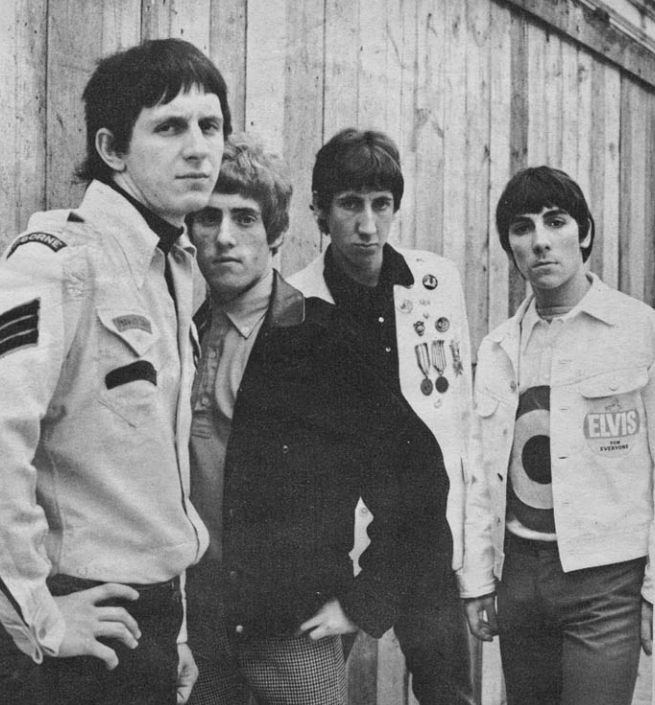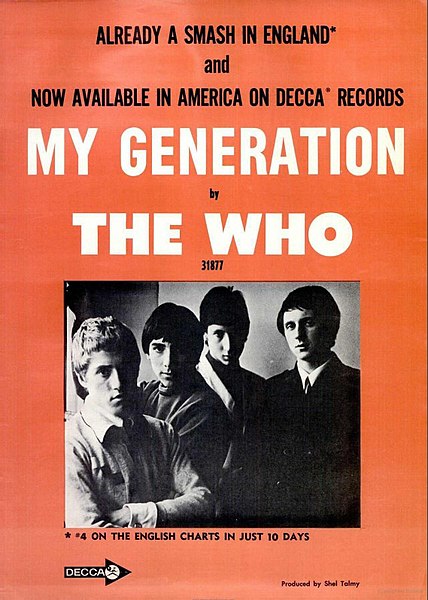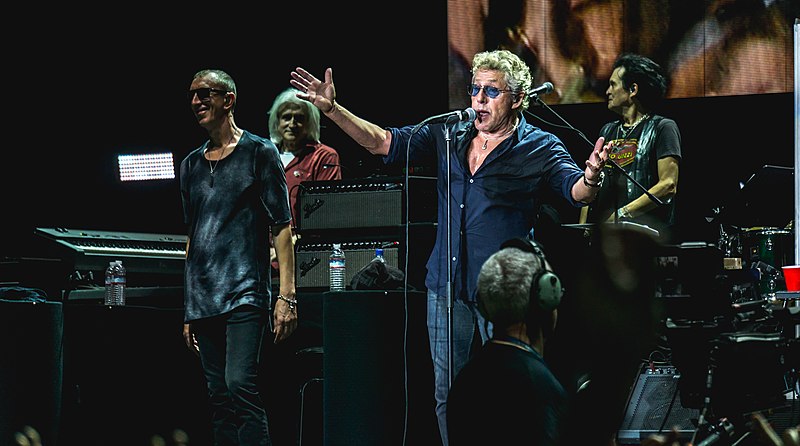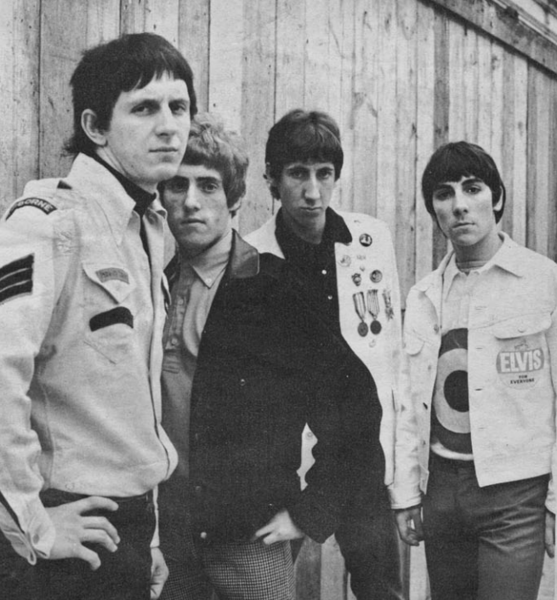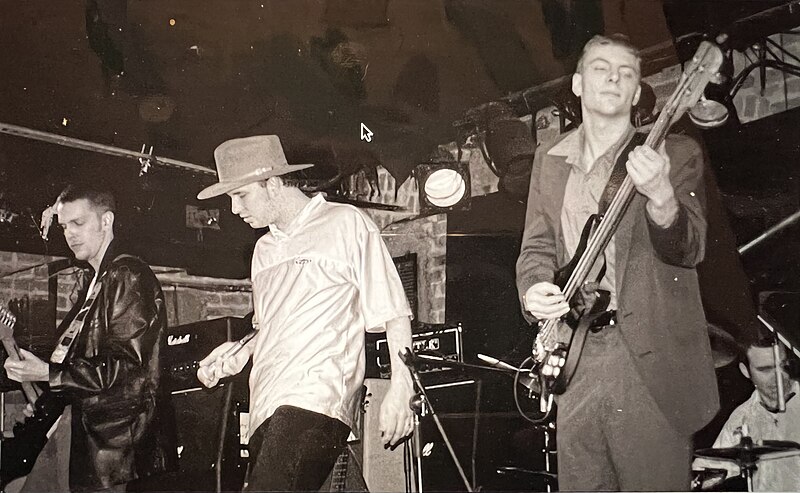Formation of The Who’s nucleus
The classic lineup of the legendary English rock band The Who consisted of Roger Daltrey, Pete Townshend, John Entwistle and Keith Moon.
Two of the original founders of the Who, Townshend and Entwistle, met while both were students at a high school in London. The two formed together a Dixieland jazz group The Confederates, with Townshend playing the banjo and Entwistle on the trumpet. However, the pair turned to evolve themselves as a rock and roll act, as rock and roll had been increasing in popularity.
Entwistle left to join another emerging rock and roll band The Detours, fronted by Roger Daltrey, who used to have a day job as a sheet-metal worker during those days. In addition to lead guitars, Daltrey also played trombone. Townshend followed Entwistle’s path to also join The Detours. By then, Daltrey gave up his guitar duties and took the chores as a lead vocalist. During this period the band’s sound continued to evolve.
Among The Who’s earliest influences were James Brown, Booker T. & the MG’s, Eddie Cochran, as well as the bands that The Who played alongside with, such as Screaming Lord Sutch, and Johnny Kidd and the Pirates, the last-mentioned band being the Detour’s biggest influence. The Detours later changed their name into The Who. Later, the band’s original drummer left, and the group added a new member Keith Moon who had previously played with a surf rock band.
Early Mod years
After having been with a couple of managers, the group handed their management again over to Peter Meaden. Under his direction, The Who changed their name into the High Numbers, and started to wear sharp suits in the Mod style. The group, as the High Numbers (their name based on the Mod vernacular) released one single which quickly fizzled out. As a result, the group sacked Meaden, the High Numbers recruited two budding entertainment entrepreneurs, Kit Lambert and Chris Stamp. The two men, who had tried their hand in directing films but failed, saw the group play on their regular venue at the Railway Hotel somewhere in London.
Lambert and Stamp found an affinity with the group, and advised them that instead of turning away from the Mod scene, the two men told them to even embrace it. The group, and in particular Townshend, were also encouraged to write their own material. Lambert and Stamp also advised them on what to play and what to wear, and later made a promotional film featuring the group at Railway.
At this point, the group renamed themselves back to The Who and highlighted their repertoire that consisted of soul, blues – or as their slogans proclaimed “Maximum R&B.”
The Who later discovered their famed onstage persona by accident. While on one of their Railway gigs, Townshend accidentally smashed his guitar while throwing it up towards the venue’s low ceiling, above the high stage. The audience’s laughing reaction incited his anger even more, proceeding to smash the guitar over and over until it was left in pieces. Then Townshend picked up another guitar and smashed it as well.
His destruction of the instruments on stage that night later made a lot of buzz, and people came in to the Railway, keen to see Townshend smash another instrument. Keith Moon followed suit by attacking his drum kit. At first, his managers were appalled, but seeing that the band’s destructive attitude onstage, Lambert in particular encouraged the band to smash more instruments as this kind of gimmick helped bring a lot of publicity to them.
Professional and financial difficulties
Townshend, as The Who’s principal songwriter, came up with one of their earliest original songs “I Can’t Explain.” The band and their managers thought that it had a great potential as a single. American producer Shel Talmy, who had produced The Kinks records (and these records include the eventual hit song “You Really Got Me,”) was eager to sign The Kinks to the American Decca Records. The Who followed this with another contract from the Decca Record’s English division.
Talmy went on to produce the single “I Can’t Explain.” At first when it was released, it received little attention, but after The Who’s appearance on Ready, Steady, Go television show, the single climbed to the UK charts, finally peaking at #8 in early 1965.
During the 1960s, The Who’s popularity continued to increase. Their first album My Generation was released in 1965. The title track, written by Townshend, was a powerful song highlighted by Entwistle’s memorable bass solo. “My Generation” peaked at #2 on the UK charts, the highest-ranking single of any chart the group has ever achieved. “My Generation” only landed at #74 on the US, but as time passed it has become one of the classic rock songs. “My Generation” indeed has become one of the 1960s most iconic anthems.
By the mid-1960s, the group and their managers had already split with Talmy, whose practices were eventually met with dissatisfaction. It led to the sudden end of their contract. The acrimony between them and Talmy continued as the managers and Talmy were trying to vie for The Who’s creative control and royalties. As a result, it ended up with Talmy owning the master tapes.
Another, the band’s routine of smashing instruments on stage led them to incur high debts, as these instruments were too expensive, even if this routine generated the publicity from the audience to check out their music. Despite the publicity, huge sales from their records and the well-attended concerts, the debts were still an outstanding concern for the group and their managers.
Townshend’s success at writing their singles inspired their managers to arrange the deal that each member to contribute their own songs. This was also seen as a way to alleviate the band from some of their mounting financial difficulties.
The result of the effort was 1966’s A Quick One, their second studio album. One of its tracks was the Townshend-penned “A Quick One, While He’s Away.” It was released as “Happy Jack” (also the title of the album) in the US. It became their first US Top 40 hit at #24, while in the UK it peaked at #3. The success was followed by “Pictures Of Lily” which reached its peak position at #4.
Rise to Fame
1960s:
- Formation – Originally known as The Detours, The Who was founded in 1964 in London, England, by guitarist Pete Townshend, vocalist Roger Daltrey, bassist John Entwistle, and drummer Keith Moon.
- Early years – Townshend’s forceful guitar playing and Daltrey’s growing vocals earned the band a reputation for their energizing live performances as they began playing gigs in tiny venues.
- Record deals – The Who obtained a record deal with Brunswick Records in 1964, and in 1965, they issued their debut single, “I Can’t Explain,” which was successful in the UK. Following that, they had a number of more hit songs, including “My Generation” and “Substitute,” which helped them become a prominent band in the British mod movement.
- Albums and hits – The hit title tune from The Who’s debut album, “My Generation,” was released in 1965. Throughout the 1960s, they continued to put out popular albums, including “A Quick One” in 1966, “The Who Sell Out” in 1967, and “Tommy” in 1969, which contained smash singles including “Happy Jack,” “I Can See for Miles,” and “Pinball Wizard.”
1970s:
- Concept albums and rock operas – The Who gained fame in the 1970s for their critically acclaimed and financially successful concept albums and rock operas, such as “Tommy” (1969), “Quadrophenia” (1973), and “Who’s Next” (1971).
- Live performances – The Who were renowned for their electrifying live performances, which were highlighted by Daltrey’s charismatic stage presence and Townshend’s recognizable windmill guitar style. They toured widely and played at important music festivals, gaining loyal fans.
- Iconic songs – In the 1970s, The Who recorded popular singles including “Won’t Get Fooled Again,” “Baba O’Riley,” and “Behind Blue Eyes” that went on to become rock music classics and further established their popularity.
- Tragedy – The band experienced tragedy in 1978 when its gifted and unique drummer Keith Moon died from a heroin overdose. The Who continued to perform and record albums throughout the 1970s despite this loss of popularity.
1980s:
- Continued successs – The Who kept on touring and put out albums like “Face Dances” (1981) and “It’s Hard” (1982), which garnered negative reviews but still did well on the charts.
- Legacy – The Who’s music continued to influence new generations of musicians and fans despite lineup changes and difficulties. They gained several honors for their contributions to rock music and were inducted into the Rock & Roll Hall of Fame in 1990.
- Reunions – The band performed at important events like Live Aid in 1985 and the closing ceremony of the 2012 London Olympics. The band had multiple reunions throughout the years, including a tremendously successful tour in 1989 commemorating “Tommy’s” 20th anniversary.
- Enduring popularity – The Who’s music remained popular throughout the 1990s and 2000s, with new audiences being introduced to their classic albums and singles. They carried on touring and playing shows, demonstrating their continuing reputation as one of the best rock bands ever.
Live Performances
The Who are known for their legendary and exciting live performances. The Who has captured audiences all over the world with their energetic shows, strong vocals, and excellent musicianship. Their performances are renowned for their charismatic stage presence, which includes the famed windmill guitar strumming of Pete Townshend, the moving vocals of Roger Daltrey, the energetic drumming of Keith Moon, and the masterful bass playing of John Entwistle.
Fans are treated to an extraordinary experience by the band during their live shows because of their raw intensity, theatricality, and connection with the crowd. The Who’s live performances have made an enduring impression on the history of rock music, from their early years as a groundbreaking rock band to their latter years as iconic rock idols.
Radical change in musical style, and American breakthrough
By the mid-1960s, changes had come their way that only added to their challenges. The popularity of Mod was fading, and Ready Steady Go ceased its broadcast. The Who found themselves in a tight competition with more hard-rockers like Jimi Hendrix and Cream.
Realizing that hitting it big in the US is of top consideration, The Who’s managers arranged for them to do a package tour in the US. Following the well-received tour, they were next invited to the Monterey Pop Festival, their first-ever major US appearance.
Tommy LP; the band’s musical and artistic differences
The Who released their third album The Who Sell Out in 1967, which featured the single “I Can See for Miles.” The single became their first American Top 10 hit, peaking at #9, even higher than the #10 UK singles position. It has become one of The Who’s classic tunes.
Tommy – A successful attempt at “rock opera”
In 1969, The Who released their fourth studio LP Tommy, their most ambitious effort to date. It was a concept album, presented in two discs, about the life of a “deaf, dumb and blind kid.” The majority of the album’s songs were written by Townshend, and produced by manager Kit Lambert. This was billed at that time as the first-ever full-scale “rock opera” production. The concept worked, as it received critical praise and commercial success. And it was their breakthrough US album, having sold two million copies there. Overall, the album has sold over 20 million units worldwide. Now, Tommy is part of the Grammy Hall of Fame.
After some five years, The Who was finally now at the forefront of British music, only next to the Beatles and Rolling Stones. Tommy had transformed The Who from a rock group that thrived only on hit singles into a widely acclaimed music band. The success of Tommy also gave Townshend a great impetus in his endeavor to push his band into another musical territory.
Townshend had become somewhat of an experimental tunesmith among the group members, especially after the success of Tommy. He would combine a number of genres such as rock, pop, opera, in lush and drawn-out pieces. Some of his band mates weren’t too keen on following his lead as they had always wanted to play simple, straight, guitar-driven and masculine hard rock.
The Who as arena rockers; Quadrophenia LP
In the 1970’s band still remained together recording and touring, and during much of the decade they settled in their newfound image as arena rockers. They subsequently released other albums Quadrophenia (1973), The Who By Numbers(1975), and Who Are You (1978). They had also overseen the production of the Tommy’s film adaptation.
Quadrophenia was another of the Who’s successful “rock opera” LP’s. Like Tommy,Quadrophenia featured two discs, and was also a concept album. This time though, the story centered on the album’s protagonist, a boy named Jimmy who had four distinct personalities, and these personalities were symbolic of each of the Who’s four members. Quadrophenia became a massive seller, and in the US it sold over a million copies going platinum in the process. The album peaked at #2 on the Billboard Hot 100, their highest-charting album yet ever as The Who would never have a #1 album in the US.
Music Styles and Equipment
Despite being predominantly recognized as a rock band, The Who have incorporated elements of various other musical genres into their work. As the Detours, the original ensemble performed R&B, traditional jazz, and current pop music in 1963. The following year, the band adopted a mod sound, especially after hearing the Small Faces combine Motown with a more abrasive R&B sound. Early material by the group was not purely pop but was oriented toward singles. Townshend first used the term “power pop” to characterize the Who’s sound in 1967. The group, like their contemporaries, was impacted by Hendrix’s arrival, especially after the Who and the Experience met in Monterey. The band’s sound was improved by this and extensive travelling. In the studio, they started to create gentler music, especially after Tommy, and they focused more on albums than singles.
Synthesizers were an element of the band’s music starting in the early 1970s, especially on Who’s Next and Quadrophenia. Despite the fact that bands have previously employed synthesizers, the Who were among the first to incorporate the sound into a fundamental rock structure. The band’s sound had shrunk to more traditional rock in By Numbers, but synthesisers made a comeback in Face Dances.
Extreme volume and distortion were made commonplace in rock by Townshend and Entwistle. The Who used Marshall Amplification before anyone else. Townshend soon after Entwistle became the first band member to receive two 412 speaker cabinets. Both live and in the studio, the group’s guitar tone included feedback. Townshend started using Dave Reeves-modified Sound City amplifiers in 1967 before switching to Hiwatt in 1970. As the first group to employ 1000-watt PA systems for live performances, the group faced competition from the Rolling Stones and Pink Floyd.
The Who’s members have claimed repeatedly throughout their careers that their live sound has never been accurately caught on tape. The audience and live performances have always been significant to the ensemble. The Who weren’t a joke; they were very real, and so were we, “Irish” Jack Lyons remarked.
Vocals
Initially drawing inspiration from Motown and rock and roll, Daltrey expanded his technique starting with Tommy. His distinctive scream, which can be heard at the end of “Won’t Get Fooled Again,” has been the band’s signature sound since it was first noted in 1983.
In the Who, group backup vocals are prevalent. After using studio singers for the backup vocals on “I Can’t Explain,” Townshend and Entwistle vowed to produce stronger backing harmonies on subsequent albums. On several tracks, Daltrey, Townshend, and Entwistle sang lead vocals, with Moon occasionally joining them. The contrast between Daltrey’s gruff, guttural voice and Townshend’s higher, softer voice is one of the album’s highlights, according to author Dave Marsh. Daltrey and Townshend shared lead vocals on many songs on Who’s Next.
He claims to be allergic to marijuana smoke, which hurts Daltrey’s voice. He smelled a joint burning on May 20, 2015, at a Who concert at Nassau Coliseum, and he warned the smoker to put it out right once or “the show will be over”. Without following Pete Townshend’s suggestion that “the quickest way” to put out a joint is “up your fucking arse,” the fan complied.
Guitars
Townshend preferred to draw attention to himself visually because he believed he lacked the technical proficiency of guitarists like Eric Clapton and Jeff Beck. His playing style, which was influenced by the banjo, evolved to favor down strokes and a mix of plectrum and fingerpicking. He is credited with creating the power chord, an accessible chord derived from the root and fifth that has since become an essential component of the vocabulary of rock guitar. His rhythm playing commonly included seventh chords and suspended fourths. Townshend also created sounds by adjusting the guitar’s settings and letting the instrument feedback.
Townshend used Rickenbacker guitars in the beginning of the band’s history because they made it easy for him to fret rhythm guitar chords and move the neck back and forth to create vibrato. From 1968 to 1973, he preferred a Gibson SG Special onstage, and afterwards utilized customized Les Pauls in various tunings.
Townshend utilized a 1959 Gretsch 6120 Chet Atkins hollow-body guitar, a Fender Bandmaster amp, and an Edwards volume pedal at the Who’s Next recording studio and afterward. All of these instruments were presented by Joe Walsh. Townshend began playing the guitar when he was young and has frequently used a Gibson J-200 for writing and recording.
Bass
Entwistle’s lead bass playing contributed significantly to the original band’s sound, while Townshend focused on the beat and the chords. Rotosound strings were initially widely used by Entwistle in 1966 in an effort to create a piano-like sound. According to Who writer John Atkins, his bassline on “Pinball Wizard” “a contribution of its own without diminishing the guitar lines”; he described his part on “The Real Me” from Quadrophenia, recorded in one take, as “a bass solo with vocals” Among Entwistle’s basses are Warwick, Alembic, Gretsch, and Guild basses, as well as a “Frankenstein” bass built from five Fender Precision and Jazz basses.
Drums
By playing lead portions on his drums, Moon expanded the reversal of conventional rock instrumentation. His approach contrasted with those of British rockers like Brian Bennett of The Shadows and Mick Avory of The Kinks, who did not think tom-toms were required for rock music. Premier uniforms were first used by Moon in 1966. He stayed away from the hi-hat and focused on a variety of tom rolls and cymbals.
Compared to Moon, Jones played the drums in a clear, supportive manner. The Who were excited to collaborate with a completely different drummer at first. Although Daltrey still praised Jones as a friend and drummer, Townshend later said, “we’ve never really been able to replace Keith.” Daltrey ultimately felt Jones was not the perfect fit for the band. Moon gave Starkey his first drum set when they were kids since they were friends. Starkey has received awards for his playing style, which resembles Moon’s but is not an exact replica.
Songwriting
In contrast to Dylan’s intellectualism, Townshend thought his lyrics should be about things youngsters could relate to. Townshend was inspired by Bob Dylan, whose lyrics dealt with topics other than the boy-girl relationships that were prevalent in rock music. Early material—which Townshend claimed was the product of “searching for [his] niche”—centered on the frustration and fear experienced by mod listeners. By The Who Sell Out, he started to incorporate storylines and characters into his songs. By Tommy, he had fully developed these elements, as well as Baba-inspired spiritual concepts. His songs started to become more intimate in the middle of the 1970s, which contributed to his choice to go solo.
In contrast, Entwistle’s songs frequently have darker themes and black humor. Because Townshend didn’t think he could create songs as “nasty” as Entwistle’s, his two contributions to Tommy—”Cousin Kevin” and “Fiddle About”—appeared.
Personal Relationships
The Who are thought to have had a difficult working relationship. Sandom had served as the mediator and peacemaker in the original band. Moon, on the other hand, was just as volatile as Townshend and Daltrey. Entwistle was too reserved to participate in conflicts. Townshend noted that all decisions had to be taken democratically “because we always disagreed” because the group’s members were insecure and aggressive, which contributed to the development of their live reputation and stage act.
Entwistle and Moon’s friendship was the only sincere one in the Who during the 1960s. They laughed at one other’s jokes and both loved going out to clubs. A “chemistry of playfullness that would go beyond playfullness” was identified by journalist Richard Green. When Entwistle got married in 1967, their bond weakened a bit, although they continued to interact while on tour. Entwistle acknowledged that he “was standing behind him with the matches” as Moon was destroying hotel restrooms.
Although Townshend claimed that disagreements were amplified in print and that the group just had trouble coming to a consensus, the group frequently engaged in conflict in the media. Because of the former’s songwriting and the latter’s stage presence, Tommy helped Townshend and Daltrey’s status in the band, but even this did not lead to the two of them becoming close friends. The two argued frequently about the direction of the group, especially in the middle of the 1970s. Daltrey occasionally criticized Jones while he was a member of the band.
Both Townshend and Daltrey were shocked by Entwistle’s passing, which led them to reexamine their marriage. According to Townshend, he and Daltrey have since gotten to know one another well. The friendship was still going strong in 2015, according to Townshend, who also noted that their tolerance of one another’s differences “brought us to a really genuine and compassionate relationship, which can only be described as love.”
Legacy and Influence
One of the most important rock groups of the 20th century was The Who. They gained notoriety as one of the best live rock acts due to their performances at Monterey and Woodstock, and they are recognized as having invented the “rock opera.” Over 100 million recordings have been sold by the group globally.
The power chord, windmill strum, and usage of non-musical instrument sounds like feedback are some of the group’s contributions to rock. With their embracing of pop art and use of the Union Jack on apparel, the band had an immediate impact on fashion. One of the “50 Moments That Changed the History of Rock ‘n’ Roll” listed by Rolling Stone magazine is the 1964 guitar-smashing incident at the Railway Hotel.
In 1966, influenced by the Who, who they regarded as a formative influence, Pink Floyd started to incorporate audience feedback from their early performances. When Jimi Hendrix first arrived in London in 1966, he went to Marshall’s music store and demanded an amp setup similar to Pete Townshend’s. He also experimented with electronic noises in ways that Townshend had pioneered. During the middle of the 1960s, The Beatles were admirers of Moon and frequently interacted with him. The Who were described as “the most exciting thing around” by Paul McCartney in 1965, who was moved to create “Helter Skelter” in the band’s “heavy” manner. John Lennon used the acoustic guitar sound from “Pinball Wizard” for “Polythene Pam.”
Hard rock and heavy metal approaches were influenced by the band’s live performances’ loud volume. The Who are cited as influences by proto-punk and punk rock bands like the MC5, the Stooges, the Ramones, the Sex Pistols, the Clash, and Green Day. Guitarist Brian May cited the Who as one of Queen’s earliest influences, calling them “one of our favorite groups.” The Jam, one of the mod revival bands that the Who impacted, helped other groups influenced by the Who gain popularity. Guns N’ Roses and other hard rock bands were influenced by The Who. The Who impacted Britpop bands like Blur and Oasis in the middle of the 1990s. The Who also had an impact on Panic! at the Disco.
Many tribute bands have been formed in honor of The Who; Daltrey has supported the Whodlums, a group that raises money for the Teenage Cancer Trust. Songs by the Who have been recorded by other bands; Elton John’s rendition of “Pinball Wizard” peaked at No. 7 in the UK.
Media
In order to maintain financial success from the Who without recording or touring, Townshend honed his talents as a music publisher throughout the Who’s hiatuses in the 1980s and 1990s. He responded to accusations of “selling out” by arguing that distributing the songs to other media gives the band more exposure and broadens its appeal.
The Who’s “Who Are You”, “Won’t Get Fooled Again”, “Baba O’Riley”, and “I Can See for Miles” serve as the theme music for the American forensic drama CSI (CSI: Crime Scene Investigation, CSI: Miami, CSI: NY, CSI: Cyber, and CSI: Vegas). The group’s songs have appeared in episodes of several well-known TV shows like The Simpsons and Top Gear, where the presenters were put in charge of being the band’s roadies in one episode.
A take of “My Generation” recorded for the BBC was used in Austin Powers: The Spy Who Shagged Me. Other films have used the band’s material in their soundtracks, including Apollo 13 (which used “I Can See For Miles”) and Tenacious D in the Pick of Destiny (which used a take of “My Generation” recorded for the BBC). The video game Rock Band and its follow-ups feature a number of the band’s songs.
Keith Moon’s death, and the Who in later years
Keith Moon was known as the “shocker” among the band members, as he was bent on destroying things for no apparent reason – from his drum kits to hotel room furniture. Drugs and drinking even exacerbated such destructive behavior.
In September 1978, Moon was found dead of overdose. The pills he had been taking at that time were meant to cure his alcohol addiction. Kenney Jones replaced Moon behind the drum kit.
The Who was even more determined to carry on after Keith’s death. They still soldiered on, continuing well into the early 80s with albums Face Dances (1981) andIt’s Hard (1982) before disbanding. However, The Who reformed occasionally for a few appearances, such as Live Aid and Qudrophenia’s anniversary tour in 1996. In 1999, the band had resumed their full touring schedule, with Zak Starkey (The Beatles’ Ringo Starr’s son) on drums.
Entwistle died in 2002, therefore abruptly stalling their album plans. The two surviving original members, Townshend and Daltrey, chose to continue recording. The result was Endless Wire in 2006, which reached both the US and UK Top Ten album charts.
Townshend and Daltrey, helped by backing musicians, still continue to tour. But there have been reports that The Who will withdraw from the limelight for good, just after their 50th anniversary tour which is slated for 2015. The Who was inducted into the Rock and Roll Hall of Fame in 1990, assured of rock royalty.

